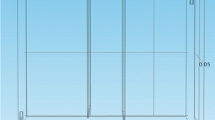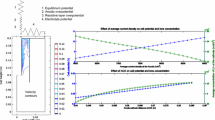Abstract
The knowledge of limiting current density and thickness of diffusion boundary layer is particularly important in improving space-time-yield of electrolysis and especially of high current-density electrolysis. Both natural and forced convection of electrolyte flow are considered in the presented computational fluid dynamics model for calculation of these values. Natural convection is modeled by implementation of a source term at the cathode surface for copper concentration according to Faraday’s law, which allows calculation of electrolyte density for each volume cell of the grid. Forced convection is considered as flow of electrolyte through the cell generated by electrolyte inlet and outlet. By variation of current density, the limiting current density can be calculated with a copperion concentration of zero at the cathode surface after reaching the steady-state conditions in electrolyte. Time dependency of diffusion boundary layer thickness is shown for a chosen cell geometry. Literature data and measured and calculated values of both quantities are in good agreement.
Similar content being viewed by others
References
N. Lbl, ⪙Die Rolle des elektrolytischen Stoff- und Ladungstransportes in der Elektrometallurgie,”Erzmetall, 22 (1969), pp. 87–98.
C.H. Hamann, and W. Vielstich, eds.,Elektrochemie (Weinheim, Germany: Wiley-VCH, 1998), pp. 177–182.
S. Patankar, ed.,Numerical Heat Transfer and Fluid Flow (New York: McGraw-Hill, 1980).
Fire® Manual, Version 6 (Graz, Austria: AVL, 1995).
A. Lackner, “Strömungssimulation in verschiedenen Reaktoren der NE-Metallurgie” (Ph.D. thesis, University of Leoben, 1996).
A. Filzwieser, “Modellierung der kathodennahen VorgÄnge in der Kupferelektroyse” (Ph.D. thesis, University of Leoben, 2000).
D.C. Price and W.G. Davenport, “Densities, Electrical Conductivities and Viscosities of CuSO4/H2SO4 Solutions in the Range of Modern Electrorefining and Electrowinning Electrolytes,”Metall, Trans., 11B (1980), pp. 159–163.
A. Filzwieser et al., “dEinsatz bipolarer Elektroden für die Hochstromelektrolyse bei der Kupfergewinnung,” BHM, 144 (1999), pp. 13–18.
R. Meyer, “Kupferfolienherstellung bei Stromdichten >1000 A/m2” (Master thesis, University of Leoben, 2000).
G. Hanko, K. Hein, and A. Filzwieser, “Visualisierung und Quantifizierung der StrömungsverhÄltnisse in einer Kupfergewinnungselektrolyse,”Erzmetall, 52 (1999), pp. 226–235.
D. Schab and K. Hein, “Problems of Anodic and CathodicMassTransfer in Copper Refining Electroylsis with Increasing Current Density,”Canad. Metall. Quart, 31 (1992), pp. 173–179.
Author information
Authors and Affiliations
Rights and permissions
About this article
Cite this article
Filzwieser, A., Hein, K. & Mori, G. Current density limitation and diffusion boundary layer calculation using CFD method. JOM 54, 28–31 (2002). https://doi.org/10.1007/BF02701653
Issue Date:
DOI: https://doi.org/10.1007/BF02701653




